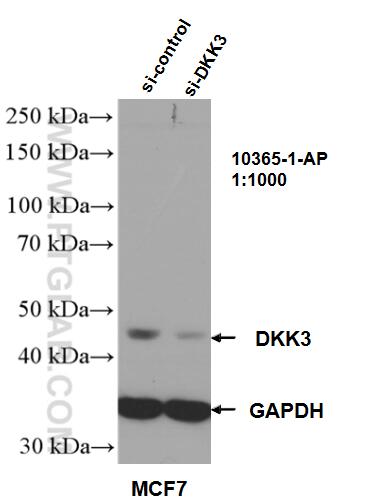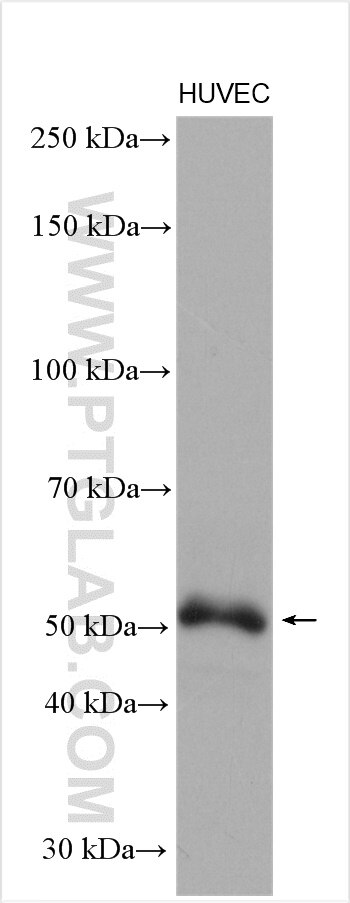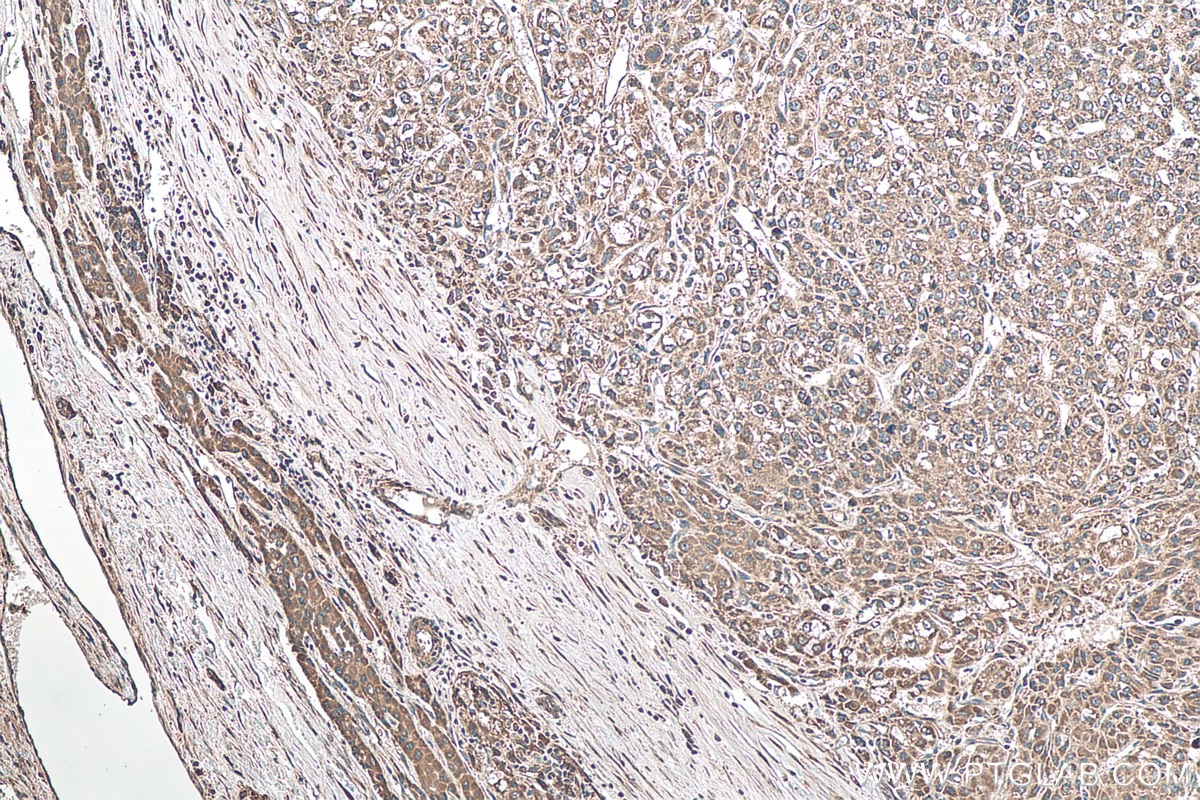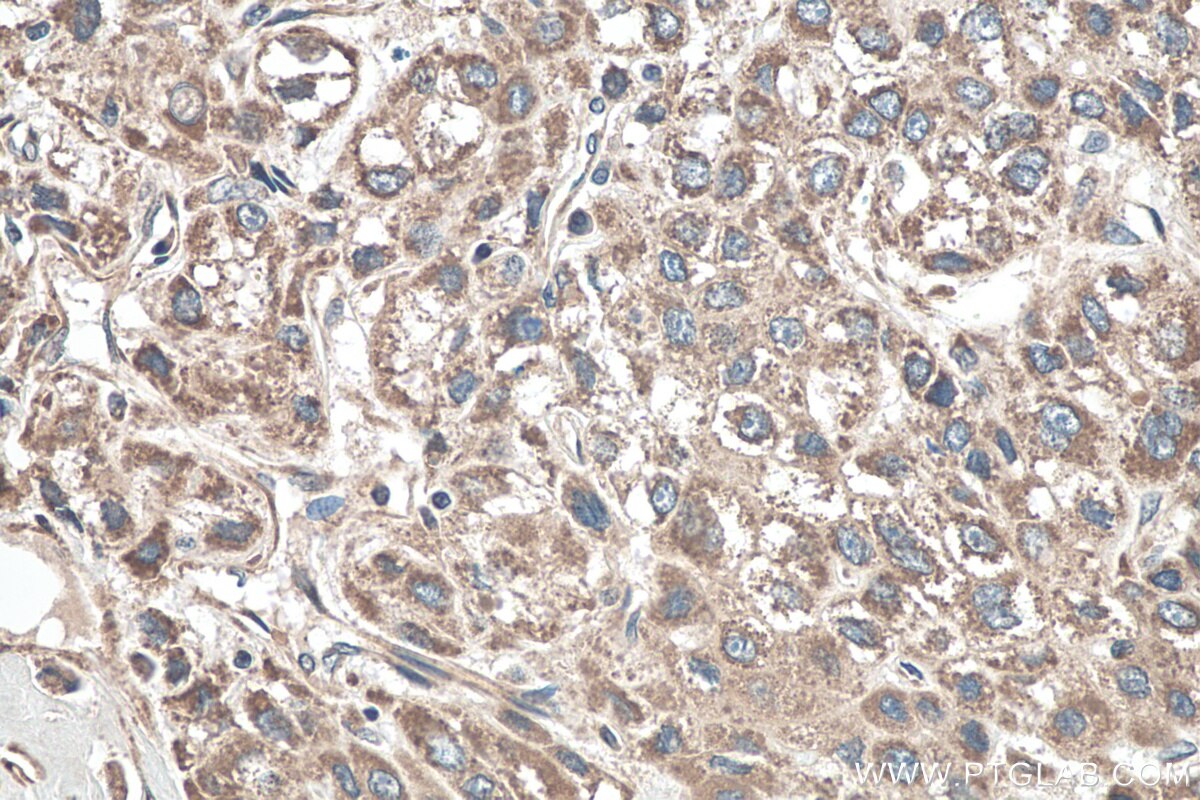Validation Data Gallery
Tested Applications
| Positive WB detected in | HUVEC cells, MCF-7 cells |
| Positive IHC detected in | human liver cancer tissue Note: suggested antigen retrieval with TE buffer pH 9.0; (*) Alternatively, antigen retrieval may be performed with citrate buffer pH 6.0 |
Recommended dilution
| Application | Dilution |
|---|---|
| Western Blot (WB) | WB : 1:500-1:2000 |
| Immunohistochemistry (IHC) | IHC : 1:250-1:1000 |
| It is recommended that this reagent should be titrated in each testing system to obtain optimal results. | |
| Sample-dependent, Check data in validation data gallery. | |
Published Applications
| KD/KO | See 1 publications below |
| WB | See 13 publications below |
| IHC | See 10 publications below |
| IF | See 9 publications below |
Product Information
10365-1-AP targets DKK3 in WB, IHC, IF, ELISA applications and shows reactivity with human, mouse samples.
| Tested Reactivity | human, mouse |
| Cited Reactivity | human, mouse, rat, canine |
| Host / Isotype | Rabbit / IgG |
| Class | Polyclonal |
| Type | Antibody |
| Immunogen |
CatNo: Ag0417 Product name: Recombinant human DKK3 protein Source: e coli.-derived, PGEX-4T Tag: GST Domain: 37-350 aa of BC007660 Sequence: ALSYPQEEATLNEMFREVEELMEDTQHKLRSAVEEMEAEEAAAKASSEVNLANLPPSYHNETNTDTKVGNNTIHVHREIHKITNNQTGQMVFSETVITSVGDEEGRRSHECIIDEDCGPSMYCQFASFQYTCQPCRGQRMLCTRDSECCGDQLCVWGHCTKMATRGSNGTICDNQRDCQPGLCCAFQRGLLFPVCTPLPVEGELCHDPASRLLDLITWELEPDGALDRCPCASGLLCQPHSHSLVYVCKPTFVGSRDQDGEILLPREVPDEYEVGSFMEEVRQELEDLERSLTEEMALGEPAAAAAALLGGEEI 相同性解析による交差性が予測される生物種 |
| Full Name | dickkopf homolog 3 (Xenopus laevis) |
| Calculated molecular weight | 38 kDa |
| Observed molecular weight | 38-55 kDa |
| GenBank accession number | BC007660 |
| Gene Symbol | DKK3 |
| Gene ID (NCBI) | 27122 |
| RRID | AB_2261615 |
| Conjugate | Unconjugated |
| Form | |
| Form | Liquid |
| Purification Method | Antigen affinity purification |
| UNIPROT ID | Q9UBP4 |
| Storage Buffer | PBS with 0.02% sodium azide and 50% glycerol{{ptg:BufferTemp}}7.3 |
| Storage Conditions | Store at -20°C. Stable for one year after shipment. Aliquoting is unnecessary for -20oC storage. |
Background Information
DKK3, also named as REIC, belongs to the dickkopf family. It antagonizes canonical Wnt signaling by inhibiting LRP5/6 interaction with Wnt and by forming a ternary complex with the transmembrane protein KREMEN that promotes internalization of LRP5/6. DKKs play an important role in vertebrate development, where they locally inhibit Wnt regulated processes such as antero-posterior axial patterning, limb development, somitogenesis and eye formation. In the adult, Dkks are implicated in bone formation and bone disease, cancer and Alzheimer's disea. The adenovirus carrying REIC/Dkk-3 (Ad-REIC) exhibits a potent tumor-specific cell-killing function for various human cancers. It has also become evident that some human cancers are resistant to Ad-REIC-induced apoptosis. The DKK3 is a Glycosylation protein with MW about 55 kDa or 38-43 kDa.
Protocols
| Product Specific Protocols | |
|---|---|
| IHC protocol for DKK3 antibody 10365-1-AP | Download protocol |
| WB protocol for DKK3 antibody 10365-1-AP | Download protocol |
| Standard Protocols | |
|---|---|
| Click here to view our Standard Protocols |
Publications
| Species | Application | Title |
|---|---|---|
Nat Cell Biol Single-cell reconstruction of the adult human heart during heart failure and recovery reveals the cellular landscape underlying cardiac function. | ||
Sci Transl Med Suppression of stromal-derived Dickkopf-3 (DKK3) inhibits tumor progression and prolongs survival in pancreatic ductal adenocarcinoma.
| ||
J Clin Invest Phosphatase WIP1 regulates adult neurogenesis and WNT signaling during aging. | ||
J Cell Mol Med Exercise ameliorates insulin resistance and improves ASK1-mediated insulin signalling in obese rats. | ||
Mol Carcinog Wnt antagonist DICKKOPF-3 (Dkk-3) induces apoptosis in human renal cell carcinoma. |




